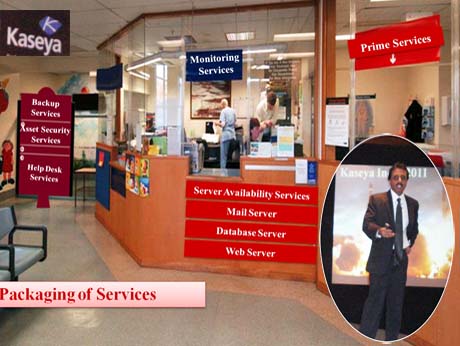
Leading global provider of IT Systems Management Software solutions, Kaseya, plans to launch its Automated ( Infrastrudture) Managed services in a pay-by-use, software-as-a-Service model by March end, seemingly targeting small and medium enterprises.
The India end of the Lausanne, Switzerland company with with 32 offices in 18 countries, claimed spectacular success in its “‘Operation 1111 by 1-1-11’ (i to achieve 1111 customers by 1st January 2011), notching up 1180 customers within a span of 90 days.
Says Kaseya India's Managing Director, Girish Krishnamurthy: “Indian CIO and IT Managers have been needlessly plagued with IT issues that are made redundant with AMS. Taking cognizance of the Indian business scenario and challenges, Kaseya India created an appropriate AMS model and standard for offering and consuming services, standardizing IT Infrastructure Management. Something that had not been done before, this was the corner stone of our strategy”. He attributed the company’s rapid customer gains to its dynamic partner ecosystem which includes PCV Infotech, Frontier Business Systems, Team computers, Value Point Pvt Ltd, Orient Technologies, HBS Systems and Zest Systems Pvt Ltd.
To effectively address the Indian market Kaseya’s Automated Managed Services offers end users the option to choose from a bouquet of carefully categorized IT services named SMART Services such as Prime Services, Monitoring Services, Standard Operating Services etc. Each SMART Service comprises a set of routine and critical IT services and provides a corresponding SMART SLA (Service Level Agreement) ensuring measurement and accountability of the services delivered.
Kaseya clients in India include, tThe Himalaya Drugs Company, Reliance Adlabs, Fortis Hospital, State Bank of India, Federal Bank, Yamaha Motors, ABB, Cipla, Bata, Religare and L&T Komatsu.
Tech note ( sourced from Kaseya collateral www.kaseya.com )
(The word Kaseya comes from the Sioux American Indian tribe and means "to secure, to protect".)What is Automated Managed Services?
Computers – It has become the lifeline of every business and of our day to day life. We use one to ensure that our business runs effectively or to perform routine tasks, such as sending an email, browsing, etc. With advances in technology and various software to perform virtually any task, the complexity of maintaining computers has increased manifold.
Traditionally in an operating environment which has Laptops, Desktops, Servers, etc. in a single location management is done the traditional way.
One, a Service Engineer or an IT team headed by an IT manager or a CIO is present in your location on a permanent basis and whenever a problem occurs or if a routine task such as deploying or updating software is required, a service engineer comes to the particular machine and ensures that it is done. In case of a small office with relatively less number of systems, an IT engineer is called on a need only basis. Both these models work, but they are time consuming and a certain amount of non productivity from your computers is inevitable. Both are popularly known as Break-fix models, where an “Issue Happens, action is taken”. However this model is fraught with risks and the chance of downtime is extremely high due to the manual intervention required at every stage.
For example, Software Deployment or Operating System Upgrade, both routine but critical tasks; now if you use a Service Engineer to perform them the time taken to install or upgrade a software or operating system in a machine is huge. The engineer has to come to the particular machine and perform the task and the user cannot use the machine during this time. If the same has to be done on multiple machines across an organization then you can imagine the time taken and the disturbance it will cause, even if the engineer takes about 30 minutes per machine. Similarly a system crashes, a service engineer comes and identifies that it is due to hardware failure, and then it is rectified, but critical data is lost and the machine is useless until repaired.
The new way which overcomes these problems is Automated Managed Services (AMS), where all routine and critical tasks involving your Computers are automated and remotely managed. To achieve this AMS is divided into a set of services called SMART Services. Each category comprises a set of services and corresponding SMART SLA (Service Line Agreements) assuring tangible results on the efficiency of the organizations IT management performance - optimizing the business value of AMS, while reducing total cost and risk.
SMART Services is a standard set of services which covers all activities that are performed on computers to ensure its good health by monitoring, identifying and taking action of all problems before they can occur. What’s more with AMS one get reports and all activities are visible to an IT Manager or CIO through transparent and clear dashboards. The proactive AMS ensures that “Issues are not allowed to Happen” by identifying and solving them before they occur. Free from the headache and hassles of managing computers enterprises can concentrate on the actual business with the peace of mind of knowing that their computers and data are safe and secure.
Kaseya has been in India for 2 years and is headquartered in Bangalore.
January 26 2011